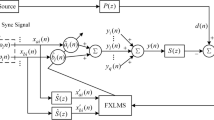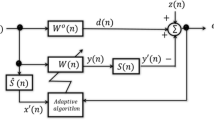Abstract
The performance of a narrowband active noise control (NANC) system can be significantly degraded due to the frequency mismatch (FM). In this paper, the statistical performance of a typical FxLMS-based NANC system in the presence of FM is analyzed in detail. Difference equations governing the system dynamics and closed-form steady-state mean-square error expressions are derived and discussed. The stochastic analysis results reveal that the FM introduces small troublesome sinusoids into the NANC system. The controller has to track these sinusoids to minimize the residual noise, which leads to a serious performance deterioration. As a by-product, the optimal step sizes that minimize the effect of a relatively small FM are also derived. The findings significantly enrich our understanding of the stochastic behavior of the FxLMS algorithm in the presence of FM and also provide some useful information for NANC system design. Extensive simulations are conducted to confirm the validity of the analytical findings.








Similar content being viewed by others
Data Availability
The authors declare that all data supporting the findings of this study are available within the article.
References
S. Bagha, D.P. Das, S.K. Behera, An efficient narrowband active noise control system for accommodating frequency mismatch. IEEE/ACM Trans. Audio Speech Lang. Process. 28, 2084–2094 (2020). https://doi.org/10.1109/TASLP.2020.3008803
J.C. Burgess, Active adaptive sound control in a duct: a computer simulation. J. Acoust. Soc. Am. 70(3), 715–726 (1981). https://doi.org/10.1121/1.386908
B. Chaplin, The cancellation of repetitive noise and vibration, in Proceedings of 1980 INTER-NOISE and NOISE-CON Congress and Conference (Inter-Noise), (1980), pp. 699–702
K. Chen, R. Paurobally, J. Pan, X. Qiu, Improving active control of fan noise with automatic spectral reshaping for reference signal. Appl. Acoust. 87, 142–152 (2015). https://doi.org/10.1016/j.apacoust.2014.07.003
C. Gong, M. Wu, J. Guo, Y. Cao, Z. Zhang, J. Yang, Modified narrowband active noise control system with frequency mismatch tolerance. Appl. Acoust. 189, 108598 (2022). https://doi.org/10.1016/j.apacoust.2021.108598
C. Gong, M. Wu, J. Guo, Y. Cao, Z. Zhang, J. Yang, Multichannel narrowband active noise control system with a frequency estimator based on DFT coefficients. J. Sound Vib. 521, 116660 (2022). https://doi.org/10.1016/j.jsv.2021.116660
R. Han, M. Wu, F. Liu, H. Sun, J. Yang, A narrowband active noise control system with a frequency estimator based on Bayesian inference. J. Sound Vib. 455, 299–311 (2019). https://doi.org/10.1016/j.jsv.2019.04.031
S. Haykin, Adaptive Filter Theory (Prentice Hall, New Jersey, 1996)
Y. Hinamoto, H. Sakai, A filtered-x LMS algorithm for sinusoidal reference signals-effects of frequency mismatch. IEEE Signal Process. Lett. 14(4), 259–262 (2007). https://doi.org/10.1109/LSP.2006.884901
C. Ho, K. Shyu, C. Chang, S.M. Kuo, Efficient narrowband noise cancellation system using adaptive line enhancer. IEEE/ACM Trans. Audio Speech Lang. Process. 28, 1094–1103 (2020). https://doi.org/10.1109/TASLP.2020.2982578
B. Huang, L. Wen, J. Sun, G. Wei, F. Ma, A variable step-size frequency mismatch compensation algorithm for narrowband active noise control, in Proceedings of 2014 International Congress on Sound and Vibration (ICSV), (2014), pp. 2214–2221
H.J. Jeon, T.G. Chang, Iterative frequency estimation based on MVDR spectrum. IEEE Trans. Power Deliv. 25(2), 621–630 (2010). https://doi.org/10.1109/TPWRD.2009.2031116
H.J. Jeon, T.G. Chang, S.M. Kuo, Analysis of frequency mismatch in narrowband active noise control. IEEE Trans. Audio Speech Lang. Process. 18(6), 1632–1642 (2010). https://doi.org/10.1109/TASL.2009.2038815
H.J. Jeon, T.G. Chang, S. Yu, S.M. Kuo, A narrowband active noise control system with frequency corrector. IEEE Trans. Audio Speech Lang. Process. 19(4), 990–1002 (2011). https://doi.org/10.1109/TASL.2010.2073705
S.M. Kuo, D.R. Morgan, Active Noise Control Systems: Algorithms and DSP Implementations (Wiley, New York, 1996)
J. Liu, Y. Xiao, J. Sun, L. Xu, Analysis of online secondary-path modeling with auxiliary noise scaled by residual noise signal. IEEE Trans. Audio Speech Lang. Process. 18(8), 1978–1993 (2010). https://doi.org/10.1109/TASL.2010.2040789
J. Liu, J. Sun, Y. Xiao, Mean-sense behavior of filtered-x LMS algorithm in the presence of frequency mismatch, in Proceedings of 2012 IEEE International Symposium on Intelligent Signal Processing and Communications Systems (ISPACS), (2012), pp. 374–379. https://doi.org/10.1109/ISPACS.2012.647351
J. Liu, X. Chen, L. Yang, J. Gao, X. Zhang, Analysis and compensation of reference frequency mismatch in multiple-frequency feedforward active noise and vibration control system. J. Sound Vib. 409, 145–164 (2017). https://doi.org/10.1016/j.jsv.2017.06.005
M.V. Matsuo, R. Seara, On the stochastic modeling of FxLMS-based narrowband active noise equalization systems. Signal Process. 115, 214–226 (2015). https://doi.org/10.1016/j.sigpro.2015.03.011
D. Morgan, An analysis of multiple correlation cancellation loops with a filter in the auxiliary path. IEEE Trans. Acoust. Speech Signal Process. 28(4), 454–467 (1980). https://doi.org/10.1109/TASSP.1980.1163430
H. Sakai, Y. Hinamoto, An exact analysis of the LMS algorithm with tonal reference signals in the presence of frequency mismatch. Signal process. 85(6), 1255–1262 (2005). https://doi.org/10.1016/j.sigpro.2004.10.021
H. Wang, H. Sun, Y. Sun, M. Wu, J. Yang, A narrowband active noise control system with a frequency estimation algorithm based on parallel adaptive notch filter. Signal Process. 154, 108–119 (2019). https://doi.org/10.1016/j.sigpro.2018.08.012
B. Widrow, S.D. Stearns, Adaptive Signal Processing (Prentice Hall, New Jersey, 1985)
Y. Xiao, Y. Tadokoro, K. Shida, Adaptive algorithm based on least mean p-power error criterion for Fourier analysis in additive noise. IEEE Trans. Signal Process. 47(4), 1172–1181 (1999). https://doi.org/10.1109/78.752620
Y. Xiao, A. Ikuta, L. Ma, L. Xu, R.K. Ward, Statistical properties of the LMS Fourier analyzer in the presence of frequency mismatch. IEEE Trans. Circuits Syst. I Regul. Pap. 51(12), 2504–2515 (2004). https://doi.org/10.1109/TCSI.2004.838315
Y. Xiao, L. Ma, K. Khorasani, A robust narrowband active noise control system for accommodating frequency mismatch, in Proceedings of 2004 European Signal Processing Conference (EUSIPCO), (2004), pp. 917–920. https://doi.org/10.5281/zenodo.38248
Y. Xiao, L. Ma, K. Khorasani, A. Ikuta, L. Xu, A filtered-x RLS based narrowband active noise control system in the presence of frequency mismatch, in Proceedings of 2005 IEEE International Symposium on Circuits and Systems (ISCAS), (2005), pp. 260–263. https://doi.org/10.1109/ISCAS.2005.1464574
Y. Xiao, R.K. Ward, L. Ma, A. Ikuta, A new LMS-based Fourier analyzer in the presence of frequency mismatch and applications. IEEE Trans. Circuits Syst. I Regul. Pap. 52(1), 230–245 (2005). https://doi.org/10.1109/TCSI.2004.838312
Y. Xiao, L. Ma, K. Khorasani, A. Ikuta, A new robust narrowband active noise control system in the presence of frequency mismatch. IEEE Trans. Audio Speech Lang. Process. 14(6), 2189–2200 (2006). https://doi.org/10.1109/TASL.2006.872604
Y. Xiao, A. Ikuta, L. Ma, K. Khorasani, Stochastic analysis of the FxLMS-based narrowband active noise control system. IEEE Trans. Audio Speech Lang. Process. 16(5), 1000–1014 (2008). https://doi.org/10.1109/TASL.2008.921756
Y. Xiao, L. Ma, K. Hasegawa, Properties of FxLMS-based narrowband active noise control with online secondary-path modeling. IEEE Trans. Signal Process. 57(8), 2931–2949 (2009). https://doi.org/10.1109/TSP.2009.2020766
Acknowledgements
This work was supported in part by the National Natural Science Foundations of China (Nos. 61971219, 61201364) and the Fundamental Research Funds for the Central Universities (NO. NJ2022016). Parts of this work were presented in the 2012 IEEE International Symposium on Intelligent Signal Processing and Communications Systems. The authors would like to thank the Associate Editor and anonymous reviewers for providing rich and instructive feedback and suggestions to improve the quality and presentation of the paper.
Author information
Authors and Affiliations
Contributions
JL contributed to conceptualization; JL contributed to methodology; JL contributed to software; JL involved in validation; JL involved in formal analysis; JL involved in data curation; JL involved in writing—original draft preparation; HC involved in writing—review and editing; JL and HC involved in funding acquisition; all authors have read and agreed to the published version of the manuscript.
Corresponding author
Ethics declarations
Conflict of interest
The authors declare that they have no known competing financial interests or personal relationships that could have appeared to influence the work reported in this paper.
Additional information
Publisher's Note
Springer Nature remains neutral with regard to jurisdictional claims in published maps and institutional affiliations.
Appendices
Appendix A: Derivation of (18)
Through \(\textbf{D}_i\) defined by (13) in [17], one easily has
and from the third step of \(\Delta \textbf{G}_i(n)\) given by (32) in [17] without applying Taylor series expansions, we have
where
Then, substituting \(\textbf{P}_i(n)\) and \(\textbf{Q}_i(n)\), respectively, defined by (29) and (30) in [17], into (15) yields (18).
Appendix B: Some Terms Used in Deriving Difference Eqs. (23) and (24)
Here, \(\textrm{sgn}(\cdot )\) and \(\delta (\cdot )\) are signum and Dirac delta functions, respectively.
Appendix C: Derivations of the Steady-State Time-Averaged MSEs (30) and (31)
Signals \(\Delta g_{a_i}(n)\), \(\Delta g_{b_i}(n)\) given in (A1) and (A2) can be recursively calculated by
Cross multiplying (21) and (22) by (C11) and (C12), one can obtain the following recursive equations:
where
From (A1), (A2), and (C13)–(C16), considering the time averaging manipulations in the steady state, one readily yields
where
Solving simultaneous equations composed of the above four equations, one easily reaches
Now, using the relations obtained above after taking the time averaging of (23) and (24), we have (30) and (31).
Rights and permissions
Springer Nature or its licensor (e.g. a society or other partner) holds exclusive rights to this article under a publishing agreement with the author(s) or other rightsholder(s); author self-archiving of the accepted manuscript version of this article is solely governed by the terms of such publishing agreement and applicable law.
About this article
Cite this article
Liu, J., Chen, H. Insights into the Filtered-x LMS Algorithm in the Presence of Frequency Mismatch. Circuits Syst Signal Process 43, 2909–2936 (2024). https://doi.org/10.1007/s00034-023-02578-x
Received:
Revised:
Accepted:
Published:
Issue Date:
DOI: https://doi.org/10.1007/s00034-023-02578-x




